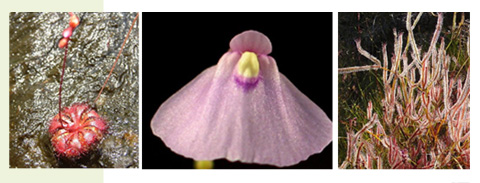Savage steppe
A little known fact about the Denniston Plateau is that it’s one of the top places to see some of New Zealand’s bizarre native carnivorous plants growing wild.

(Left to right) Drosera spatulata, Utricularia dichotoma flower, Peter Elhardt. Drosera binata, Noah Elhardt. Photos licensed under Creative Commons
New Zealand has twelve native carnivorous plants: four types reside on this alpine sandstone plateau which is under threat from coal mining.
For many people, carnivorous plants hold a certain fascination – these seemingly benign, stationary plants turn the tables on insects, trapping them in goo, or nifty traps, so they can devour them at their leisure.
Carnivorous plants use these insect-snacks to supplement their nutrient-load because they live in water-logged, peaty nutrient-poor soil, such as bogs and mountaintops.
And although NZ may not have large tropical pitcher plants, that can harbour communities of frogs and spiders, or the Venus Flytrap with its snap traps, we have a number of fascinating predatory plants.
Interestingly, carnivorous plants aren’t from the same family. Plants such as bladderworts and sundews formed insect trapping devices independently of each other, and they ensnare their prey using quite different methods.
Sundews trap insects on leaves that are covered in many tiny, bright tentacles. Each tentacle has a mucilage-producing gland on the tip. In the sunlight, sundews look amazing, covered in glistening, sticky droplets. Landing insects get stuck on the tentacles, and the more they struggle, the more they become gummed up in the oozing mucilage, which is not only the superglue of the plant world, but contains digestive enzymes.
The leaves of many sundew species can also rapidly bend around their prey –capturing it more securely as well as enabling the plant’s leaves to better digest and absorb the prey’s nutrients.
Bladderworts have a very different hunting method.
Some grow in water; others in peat swamps. They generally look unassuming above the surface, even pretty with their small, sometimes fragrant flowers. However, below the surface, they lay the most sophisticated traps of any carnivorous plant.
They have a network of stems that grow along the ground and underground which are dotted along with a series of small vacuum traps.
These traps have doors sealed with mucilage, and tiny hairs on the outside. When an organism swimming past triggers a hair, this breaks the seal on the trapdoor. It whips open, the vacuum sucks in the creature, and the door closes, all within milliseconds.
Researcher Bruce Salmon has, over many years, travelled the country in search of native carnivorous plants. His book Carnivorous Plants of New Zealand is full of information, as well as stunning photographs and ideas for field trips to observe these treasures in their natural environments.
He describes how on the road up to the Denniston Plateau he found thousands of Drosera spatulata – along with some Drosera binata – growing vertically on water-washed cliffs, amongst mosses. Further up, he saw more Drosera spatulata, as well as Urtricularia dichotoma, in what he describes as ‘the weathered sandstone moonscape’.
For interested explorers there, Bruce advises: ‘The best time to see then is during summer, between December and February. Allow 2-3 hours for fossicking.’
But what will become of Denniston Plateau’s carnivorous plant communities if the mining goes ahead?
Around the world, many carnivorous plants are considered indicator species, sensitive to small changes in their environment. In New Zealand, as well as globally, carnivorous plants are under threat; their populations ever diminishing as their habitats are cleared, drained or poisoned by new residential and industrial developments, as well as farm run-off.
Do we really need to lose one more habitat?
Attention Predatory Plant Enthusiasts: On 2 – 4 March, Forest & Bird is leading a weekend Bioblitz on the Denniston Plateau – a chance to uncover these gems of the plateau, as well as other plants and animal life. Fossickers and nature enthusiasts of all persuasions are invited to attend. More details can be found here
If you would like to learn more about carnivorous plants, join the carnivorous plant society – http://www.nzcps.co.nz/
